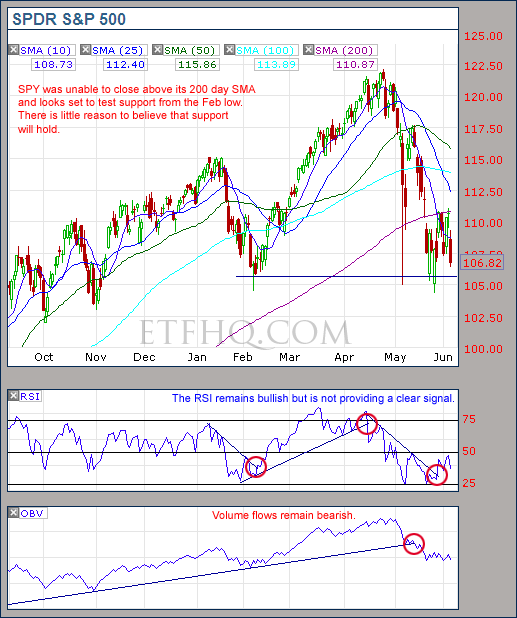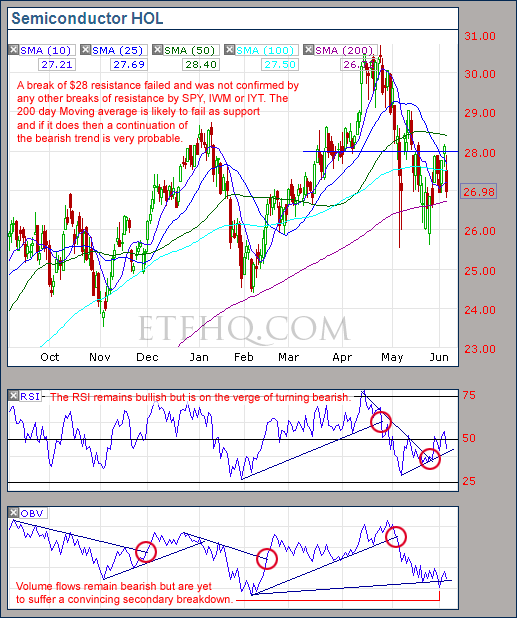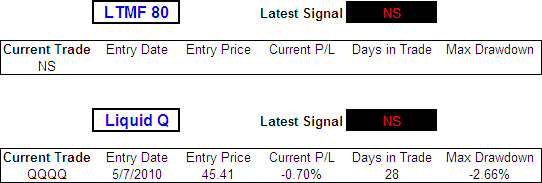June 07, 2010 – 12:35 am ET
New Blog Posts – Have you ever wondered if any of the common technical indicators can actually beat a buy and hold approach to the market? Well we are staging a Technical Indicator – Fight for Supremacy. The first round if testing is now complete; we look at Moving Averages – Simple Vs. Exponential. Find out which one is superior once and for all.
To the market – Last week was looking quite good until Friday when there were significant declines that erased the prior gains. We laid down several resistance levels that needed to be broken in order to indicate a return to the bull market noting: “The more likely outcome however is that resistance will hold and we will see further consolidation before a continuation of the bear market.” So far the market continues to track this more probable outcome.
——————–
Lets get the conversation started on Facebook
also access special downloads.
——————–
.
ETF % Change Comparison
.
It is now 50 days since SMH peaked and all of the influential ETFs are down over 10% from their highs this year. The small caps and the transports were the hardest hit over the last week while SMH and QQQQ held together comparatively well. It is good to see technology stocks showing strength but theses declines are hardly anything to be positive about.
.
What the % Comparison Table Tells Us:
By comparing the performance of the economically sensitive (SMH, QQQQ, IWM, IYT) and the comparatively stable ETFs (SPY and DIA) we can get an indication of the true market direction. The more sensitive areas of the market tend to be the first to initiate a trend change. For example if DIA and SPY sell off heavily while SMH and IWM (Russell 2000 small cap ETF) sell of mildly or continue moving to new highs then this would be very positive and vice versa.
The ‘Average Rank %’ is calculated by subtracting the % change for each ETF from the maximum % change and dividing it by the range for each period. 1-((MAX(% change all ETFs)-ETFs % Change)/(MAX(% change all ETFs)-MIN(% change all ETFs))) The readings for each period are then averaged. This reading is provided because if one ETF was significantly under/out performing the others then a plain high or low rank would not accurately reflect this.
.
![]()
.
A Look at the Charts
.

A close by SPY below the Feb low will cause some major technical damage.
.

A loss of the 200 Day SMA support by QQQQ and a secondary breakdown from OBV would be very bearish.
.
If SMH closes below its 200 day SMA, has a secondary breakdown by OBV and the RSI turns bearish, this will provide good confirmation of a continuation in the bearish trend.
.

IWM has very important support at $62.50. If this level is lost and OBV suffers a secondary breakdown we are likely to see some real declines.
.
If IYT closes below its 200 day SMA and OBV suffers a secondary breakdown then we start moving into serious bear market territory.
.
![]()
.
OM3 Weekly Indicator
.

For 6 weeks now the OM3 indicator has been warning of bearish action ahead. It remains firmly bearish.
.
How to read the OM3 indicator
The OM3 indicator as with most of our models primarily reads price action and volume. The strong/weak buy/sell signals are self-explanatory. ‘No Signal’ means that the component readings are in conflict and cancel each other out.
The alerts let you know if the cycle is speeding up or slowing down, so when you get at ‘Strong Buy, Bear Alert’ for instance it simply means that the criteria for a strong buy is in place but this weeks cycle reading is weaker (or more bearish) than last weeks reading (the same is true in reverse).
The number of weeks that a signal has been repeated is displayed. Historically a ‘Strong Buy’ signal has lasted for an average of 6 weeks and a maximum of 42 weeks, while a ‘Strong Sell’ has lasted for an average of 4 weeks and a maximum of 16.
This is an indicator not a mechanical trading model. It is useful to assist in analyzing the market but for the best results should be combined with commonsense and support/resistance levels etc.
.
![]()
.
TransDow & NasDow
.
After a rocky 14 days the Dow has gained dominance over the NASDAQ and the NasDow has closed out its position on the NASDAQ for a small -0.44% loss. The Transports however remain dominant over the Dow after 98 days but nearly all the profits are now gone from the TransDow trade.
Over the last 98 days the Transports are up 0.55% while the Dow is down 3.81%, also the NASDAQ has declined -0.44% over the last 14 days while the Dow is down -2.56%. This shows that the models are working correctly by identifying the better performing index and thus winning by not losing.
.
What the TransDow Readings tell us:
The TransDow measures dominance between the DJ Transportation Index (DJTI) and the Dow Jones Industrial Average (DJIA). In a strong market the more economically sensitive Transportation Index should be dominant over the DJIA.
Historically the DJTI has been dominant over the Dow 45% of the time. The annualized rate of return from the DJTI during this period was 18.47% with the biggest loss for one trade sitting at -13.27%. The annualized return from the DJIA during the periods it was dominant over the DJTI was just 4.06% and the biggest loss for one trade was -16.13%. A 4% stop-loss is applied to all trades adjusting positions only at the end of the week.
What the NasDow Readings tell us:
The NasDow measures dominance between the NASDAQ and the DJIA. Using the same theory behind the Trans Dow; in a strong market the more economically sensitive NASDAQ should be dominant over the DJIA.
Historically the NASDAQ has been dominant over the DJIA 44% of the time. Taking only the trades when the NASDAQ is above its 40 week moving average the annualized rate of return was 25.47% with the biggest loss for one trade sitting at –8.59%. The annualized rate on the DJIA during the periods it was dominant over the NASDAQ is just 8.88% and the biggest loss for one trade was –12.28%. A 8% stop-loss is applied to all trades adjusting positions only at the end of the week.
.
![]()
.
LTMF 80 & Liquid Q
.

Liquid Q has closed out its position in QQQQ for a small loss of -0.70% after 28 days in a wild market.
.
Historical Stats:
.

.
How The LTMF 80 Works
LTMF stands for Long Term Market Forecaster. It reads volume flows relative to price action and looks for out performance of volume measured on a percentage basis over the prior 12 months. During a sustained rally the readings will reach high levels (near 100%) making it imposable for the volume reading to always outperform price so any reading above 80% will maintain the buy signal. This system has outperformed the market over the last 10 years but performance has been damaged by some nasty losses. It only produces buy signals and only for QQQQ.
How Liquid Q Works
Liquid Q completely ignores price action and instead measures the relative flow of money between a selection of economically sensitive and comparatively stable ares of the market. It looks for times when the smart money is confident and and can be seen by through volume investing heavily is more risky areas due to an expectation of expansion. This system has outperformed the market over the last 10 years and remained in cash through most of the major declines. It only produces buy signals and only for QQQQ. We will provide more performance details on the web site for these systems soon.
.
![]()
.
Summary
.
The resistance levels listed last week have all held strong so the bearish trend remains intact and now some of the bullish arguments have gone: The Dow is again dominant over the NASDAQ and Liquid Q is back in cash. That said we are yet to see secondary breakdowns from OBV or a loss of support. I will be looking for the following to confirm a continuation of the bearish trend:
- SPY close below 105.89 (Feb Low)
- QQQQ close below 200 Day SMA and OBV secondary breakdown
- SMH close below 200 Day SMA, OBV secondary breakdown and RSI turning bearish
- IWM close below $62.50 and OBV secondary breakdown
- IYT close below 200 Day SMA and OBV secondary breakdown
It would not be surprising to see all of these occur by Mondays close but until they do we are likely to be range bound in a bear market.
.
Any disputes, questions, queries, comments or theories are most welcome in the comments section below.
.
Derry
And the Team @ ETF HQ
“Equipping you to win on Wall St so that you can reach your financial goals.”
.
P.S Like ETFHQ on Facebook – HERE
.
![]()
.
The Devils Dictionary – S
Sales – The art of separating a customer from his money.
Secured Creditors – In modern American capitalism, the parties last in line for repayment after a company’s failure. The others in line include the government, unions, sundry suppliers, friends of the union, friends of the government, unsecured creditors and people vaguely familiar with the matter.
SIV – Special Investment Vehicle designed to circumvent GAAP off-balance sheet consolidation by moving risky assets on the balance sheets of financial institutions who don’t have enough capital to support their reckless activities to off-balance sheet entities owned by no one of any significance. SIV’s pronunciation as an acronym is self defining.
Standard & Poor – Your life in a nutshell.
Stock Analyst – Idiot who just downgraded your stock.
Stock Split – When your ex-wife and her lawyer split your assets equally between themselves.
Subprime – An ingenious method of granting credit to the poor, thereby narrowing the wealth gap between the classes. Dick Fuld (Final Chairman and CEO of Lehman Brothers) lost $650 million after Lehman’s subprime bets went sour.